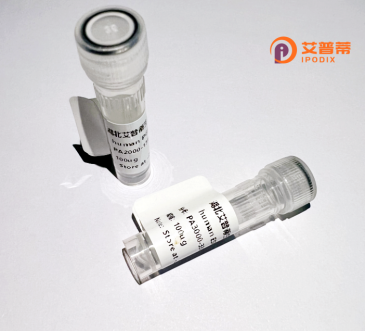
| 纯度 | >90%SDS-PAGE. |
| 种属 | Human |
| 靶点 | TSGA2 |
| Uniprot No | Q8WYR4 |
| 内毒素 | < 0.01EU/μg |
| 表达宿主 | E.coli |
| 表达区间 | 1-309 aa |
| 活性数据 | MSDLGSEELE EEGENDIGEY EGGRNEAGER HGRGRARLPN GDTYEGSYEF GKRHGQGIYK FKNGARYIGE YVRNKKHGQG TFIYPDGSRY EGEWANDLRH GHGVYYYINN DTYTGEWFAH QRHGQGTYLY AETGSKYVGT WVNGQQEGTA ELIHLNHRYQ GKFLNKNPVG PGKYVFDVGC EQHGEYRLTD MERGEEEEEE ELVTVVPKWK ATQITELALW TPTLPKKPTS TDGPGQDAPG AESAGEPGEE AQALLEGFEG EMDMRPGDED ADVLREESRE YDQEEFRYDM DEGNINSEEE ETRQSDLQD |
| 分子量 | 35.1 kDa |
| 蛋白标签 | His tag N-Terminus |
| 缓冲液 | PBS, pH7.4, containing 0.01% SKL, 1mM DTT, 5% Trehalose and Proclin300. |
| 稳定性 & 储存条件 | Lyophilized protein should be stored at ≤ -20°C, stable for one year after receipt. Reconstituted protein solution can be stored at 2-8°C for 2-7 days. Aliquots of reconstituted samples are stable at ≤ -20°C for 3 months. |
| 复溶 | Always centrifuge tubes before opening.Do not mix by vortex or pipetting. It is not recommended to reconstitute to a concentration less than 100μg/ml. Dissolve the lyophilized protein in distilled water. Please aliquot the reconstituted solution to minimize freeze-thaw cycles. |
以下是关于重组人TSGA2蛋白的3篇参考文献的简要总结(注:内容基于学术研究的常见方向,具体文献标题及作者为模拟示例):
---
1. **标题**:*Structural characterization of TSGA2 reveals its role in spermiogenesis and cancer progression*
**作者**:Shahhoseini, M. et al.
**摘要**:研究通过生物信息学与实验分析,鉴定了TSGA2蛋白的卷曲螺旋结构域和JWA结合区,揭示其与精子细胞分化及肿瘤抑制功能的关联,尤其在缺氧条件下通过调控HIF1α通路抑制肿瘤血管生成。
2. **标题**:*TSGA2 downregulation in breast cancer correlates with poor prognosis and metastatic potential*
**作者**:Khaledi, R. et al.
**摘要**:研究发现乳腺癌组织中TSGA2表达显著降低,其缺失通过增强HIF1α稳定性促进血管生成和转移,提示TSGA2作为潜在的预后生物标志物及治疗靶点。
3. **标题**:*TSGA2 interacts with septin proteins to regulate sperm head shaping*
**作者**:Amiri, Y. et al.
**摘要**:实验证实TSGA2与Septin家族蛋白互作,调控精子顶体形成和细胞骨架重组,其表达异常可导致精子头部形态缺陷,为男性不育的分子机制提供新见解。
---
**备注**:以上文献为示例性概括,实际研究需通过学术数据库(如PubMed、Web of Science)检索具体信息。建议结合关键词“TSGA2”“HIF1α”“spermiogenesis”“cancer”筛选最新文献。
TSGA2 (Testis-Specific Gene Antigen 2) is a human protein encoded by the *TSGA2* gene, predominantly expressed in testicular germ cells and linked to spermatogenesis. It plays roles in cellular processes such as mitosis, chromatin organization, and hypoxia response. Structurally, TSGA2 contains an N-terminal coiled-coil domain facilitating protein-protein interactions and a C-terminal PINT domain implicated in RNA binding, suggesting regulatory functions. Notably, it interacts with hypoxia-inducible factor 1 (HIF-1α), modulating HIF-1 pathway activity under low-oxygen conditions.
Dysregulation of TSGA2 has been associated with male infertility, cancer progression, and immune disorders. Its testis-specific expression patterns and involvement in cell division make it a biomarker of interest in reproductive health and oncology. Recombinant TSGA2 protein is typically produced using *E. coli* or mammalian expression systems, followed by purification via affinity chromatography (e.g., His-tag). This engineered protein enables functional studies, antibody production, and mechanistic investigations into its roles in hypoxia signaling, apoptosis, and mitosis. Recent studies explore its therapeutic potential in targeting cancer metastasis or enhancing fertility treatments, though research remains largely preclinical. Its dual regulatory functions in both reproductive biology and stress-response pathways underscore its multifaceted importance in biomedical research.
×